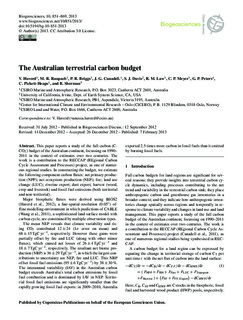The Australian terrestrial carbon budget
Haverd, V.; Raupach, MR; Briggs, P.R.; Canadell, JG; Davis, S.J.; Law, R.M.; Meyer, C.P.; Peters, Glen Philip; Pickett-Heaps, C.; Sherman, B.
Journal article, Peer reviewed
Published version
Permanent lenke
http://hdl.handle.net/11250/2465323Utgivelsesdato
2013Metadata
Vis full innførselSamlinger
- Journal articles [478]
Sammendrag
This paper reports a study of the full carbon (C-CO2) budget of the Australian continent, focussing on 1990–2011 in the context of estimates over two centuries. The work is a contribution to the RECCAP (REgional Carbon Cycle Assessment and Processes) project, as one of numerous regional studies. In constructing the budget, we estimate the following component carbon fluxes: net primary production (NPP); net ecosystem production (NEP); fire; land use change (LUC); riverine export; dust export; harvest (wood, crop and livestock) and fossil fuel emissions (both territorial and non-territorial). Major biospheric fluxes were derived using BIOS2 (Haverd et al., 2012), a fine-spatial-resolution (0.05°) offline modelling environment in which predictions of CABLE (Wang et al., 2011), a sophisticated land surface model with carbon cycle, are constrained by multiple observation types. The mean NEP reveals that climate variability and rising CO2 contributed 12 ± 24 (1σ error on mean) and 68 ± 15 TgC yr−1, respectively. However these gains were partially offset by fire and LUC (along with other minor fluxes), which caused net losses of 26 ± 4 TgC yr−1 and 18 ± 7 TgC yr−1, respectively. The resultant net biome production (NBP) is 36 ± 29 TgC yr−1, in which the largest contributions to uncertainty are NEP, fire and LUC. This NBP offset fossil fuel emissions (95 ± 6 TgC yr−1) by 38 ± 30%. The interannual variability (IAV) in the Australian carbon budget exceeds Australia's total carbon emissions by fossil fuel combustion and is dominated by IAV in NEP. Territorial fossil fuel emissions are significantly smaller than the rapidly growing fossil fuel exports: in 2009–2010, Australia exported 2.5 times more carbon in fossil fuels than it emitted by burning fossil fuels.
